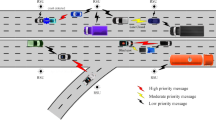Abstract
Vehicular Ad Hoc Network (VANET) is an emerging field of technology that allows vehicles to communicate together in the absence of fixed infrastructure. The basic premise of VANET is that in order for a vehicle detect other vehicles in the vicinity. This cognizance, awareness of other vehicles, can be achieved through beaconing. In the near future, many VANET applications will rely on beaconing to enhance information sharing. Further, the uneven distribution of vehicles, ranging from dense rush hour traffic to sparse late night volumes creates a pressing need for an adaptive beaconing rate control mechanism to enable a compromise between network load and precise awareness between vehicles. To this end, we propose an intelligent Adaptive Beaconing Rate (ABR) approach based on fuzzy logic to control the frequency of beaconing by taking traffic characteristics into consideration. The proposed ABR considers the percentage of vehicles traveling in the same direction, and status of vehicles as inputs of the fuzzy decision making system, in order to tune the beaconing rate according to the vehicular traffic characteristics. To achieve a fair comparison with fixed beaconing schemes, we have implemented ABR approach in JIST/SWANs. Our simulation shows that the proposed ABR approach is able to improve channel load due to beaconing, improve cooperative awareness between vehicles and reduce average packet delay in lossy/lossless urban vehicular scenarios.
Similar content being viewed by others
References
Wireless access for vehicular environment (wave), December 2010. http://www.standards.its.dot.gov/factsheet.aspf=80.
van Eenennaam, E. M., Wolterink, W. K., Karagiannis, G., & Heijenk, G. (2009). Exploring the solution space of beaconing in vanets. In Vehicular networking conference (VNC) (pp. 1–8). New York: IEEE Press.
Torrent-Moreno, M., Santi, P., & Hartenstein, H. (2007). Distributed fair transmit power adjustment for vehicular ad hoc networks. In 3rd annual IEEE communications society on sensor and ad hoc communications and networks (Vol. 2, pp. 479–488). New York: IEEE Press.
Nzouonta, J., Rajgure, N., Wang, G., & Borcea, C. (2009). Vanet routing on city roads using real-time vehicular traffic information. IEEE Transactions on Vehicular Technology, 58(7), 3609–3626.
Barr, R. An efficient, unifying approach to simulation using virtual machines. PhD thesis, Citeseer (2004).
Artimy, M. (2007). Local density estimation and dynamic transmission-range assignment in vehicular ad hoc networks. IEEE Transactions on Intelligent Transportation Systems, 8(3), 400–412.
Yang, L., Guo, J., & Wu, Y. (2008). Channel adaptive one hop broadcasting for vanets. In 11th international IEEE conference on intelligent transportation systems (pp. 369–374).
van Eenennaam, E. M., Karagiannis, G., & Heijenk, G. (2010). Towards scalable beaconing in vanets. In Fourth ERCIM workshop on emobility (pp. 103–108).
Rezaei, S., Sengupta, R., Krishnan, H., Guan, X., & Student, P. (2008) Adaptive communication scheme for cooperative active safety system.
Rezaei, S., Sengupta, R., Krishnan, H., & Guan, X. (2007). Reducing the communication required by dsrc-based vehicle safety systems. In IEEE intelligent transportation systems conference (ITSC) (pp. 361–366).
Fukui, R., Koike, H., & Okada, H. (2002). Dynamic integrated transmission control (ditrac) over inter-vehicle communications in its. In IEEE vehicular technology conference (Vol. 1, pp. 483–487).
Schmidt, R. K., Leinmuller, T., Schoch, E., Kargl, F., & Schafer, G. (2010). Exploration of adaptive beaconing for efficient intervehicle safety communication. IEEE Network, 24(1), 14–19.
Huang, C. J., Chen, I. F., Hu, K. W., Shen, H. Y., Chen, Y. J., & Yang, D. X. (2009). A load balancing and congestion-avoidance routing mechanism for teal-time traffic over vehicular networks. Journal of Universal Computer Science, 15(13), 2506–2527.
Mamdani, E. H. (1977). Application of fuzzy logic to approximate reasoning using linguistic synthesis. IEEE Transactions on Computers (pp. 1182–1191).
Kerner, B. S. (2004). The physics of traffic: empirical freeway pattern features, engineering applications, and theory. Berlin: Springer.
Myllyniemi, M., Vehkapera, J., & Peltola, J. (2007). Fuzzy logic-based cross-layer controller for wireless video transmission. In 12th IEEE symposium on computers and communications (pp. 21–26).
jfuzzylogic, December 2010. http://jfuzzylogic.sourceforge.
Choffnes, D. R., & Bustamante, F. E. (2005). An integrated mobility and traffic model for vehicular wireless networks. In Proceedings of the 2nd ACM international workshop on Vehicular ad hoc networks (p. 78). New York: ACM.
Tiger,tiger line and tiger related products. u.s. census bureau, December 2010. http://www.census.gov/geo/www/tiger/.
Mittag, J., Thomas, F., Harri, J., & Hartenstein, H. (2009). A comparison of single-and multi-hop beaconing in vanets. In Proceedings of the sixth ACM international workshop on VehiculAr InterNETworking (pp. 69–78). New York: ACM.
Rappaport, T. S. (1996). Wireless communications: principles and practice. Englewood Cliffs: Prentice Hall.
Villalón, J., Cuenca, P., & Orozco-Barbosa, L. (2008) Efficient joint unicast/multicast transmission over IEEE 802.11e wlans. Wireless and Mobile Networking (pp. 109–121).
Author information
Authors and Affiliations
Corresponding author
Rights and permissions
About this article
Cite this article
Zrar Ghafoor, K., Abu Bakar, K., van Eenennaam, M. et al. A fuzzy logic approach to beaconing for vehicular ad hoc networks. Telecommun Syst 52, 139–149 (2013). https://doi.org/10.1007/s11235-011-9466-8
Published:
Issue Date:
DOI: https://doi.org/10.1007/s11235-011-9466-8




